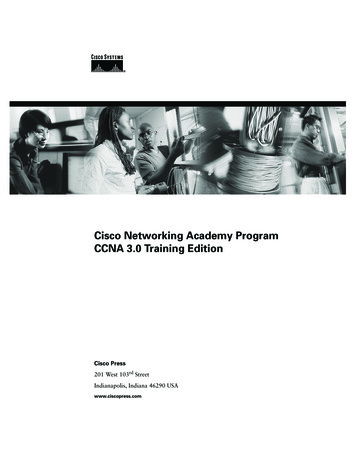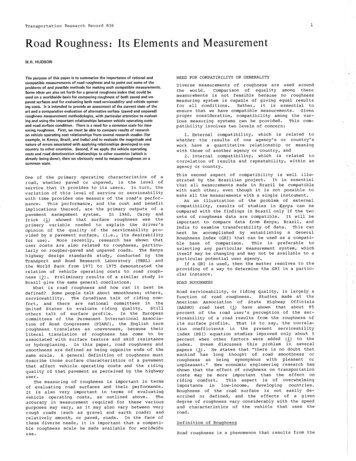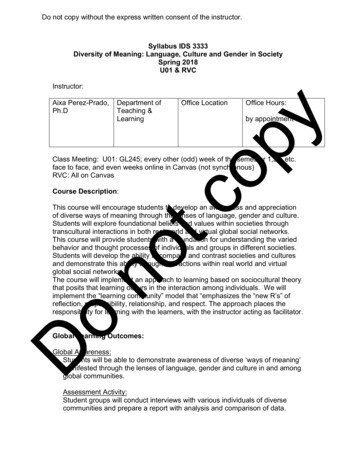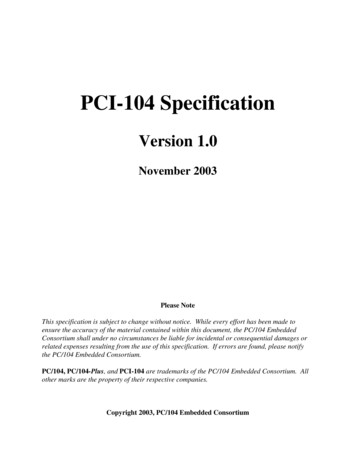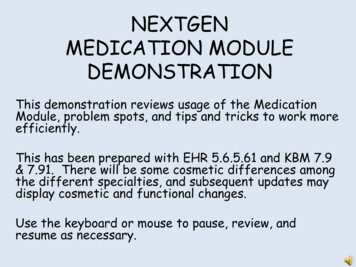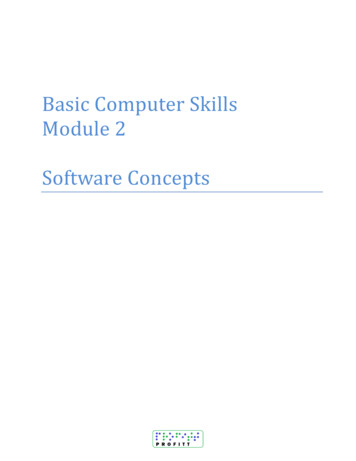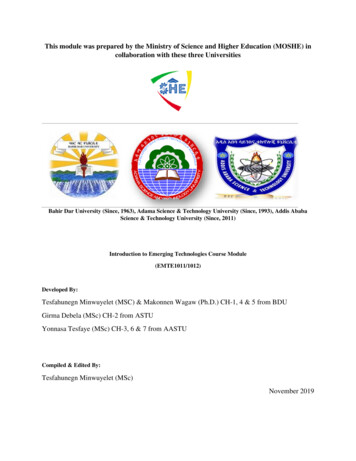
Transcription
This module was prepared by the Ministry of Science and Higher Education (MOSHE) incollaboration with these three UniversitiesBahir Dar University (Since, 1963), Adama Science & Technology University (Since, 1993), Addis AbabaScience & Technology University (Since, 2011)Introduction to Emerging Technologies Course Module(EMTE1011/1012)Developed By:Tesfahunegn Minwuyelet (MSC) & Makonnen Wagaw (Ph.D.) CH-1, 4 & 5 from BDUGirma Debela (MSc) CH-2 from ASTUYonnasa Tesfaye (MSc) CH-3, 6 & 7 from AASTUCompiled & Edited By:Tesfahunegn Minwuyelet (MSc)November 2019
Module PrefaceThis resource module is designed and developed in support of the Introduction to EmergingTechnology Curriculum. It provides learning resources and teaching ideas.Dear students, in chapter one you have been studied about the evolution of technologies, the roleof data for emerging technologies, programmable devices, human to machine interaction andfuture trends in emerging technologies within week 1-2.In chapter two, data science and Big data have been studied, how we collect, analyzed, stored andused. The advantages and disadvantages of big data analysis are also studied within weeks 3-4.In chapter three, you have been studied about introduction to Artificial Intelligence; its history;different types of AI; its application in health, education, agriculture, and business. Finally,different tools and platforms used for AI and sample AI examples were studied within week 5-7.In chapter four, the overview of the Internet of Things; its history; its pros and cons, its architecture,its application in the smart home, smart city, smart grid and smart farming. In the end, all IoT toolsand platforms, as well as the sample applications, are well studied within weeks 8-10.Chapter five is about augmented reality (AR), its difference and similarity from virtual reality andmixed reality, how it works, its architecture, and applications were studied within weeks 11-12.Chapter six is all about the connection of emerging technologies with professional ethics, privacy,accountability, trust. Finally, the threats and challenges of the technologies have been discussedwithin week 13.In chapter seven, other emerging technologies that are not covered in detail are discussed.Nanotechnology, Biotechnology, Blockchain technology, Cloud and quantum computing,Autonomic computing, Computer vision, Embedded systems, Cybersecurity, and AdditiveManufacturing (3D Printing) were studied within week 14-15.1
Table of ContentsChapter 1: Introduction to Emerging Technologies . 8Evolution of Technologies . 81.11.1.1Introduction to the Industrial Revolution (IR) . 101.1.2The Most Important Inventions of the Industrial Revolution . 111.1.3Historical Background (IR 1.0, IR 2.0, IR 3.0) . 111.2Role of Data for Emerging Technologies . 141.3Enabling devices and network (Programmable devices) . 151.3.11.4Human to Machine Interaction . 171.4.11.5List of some Programmable devices . 16Disciplines Contributing to Human-Computer Interaction (HCI) . 17Future Trends in Emerging Technologies . 181.5.1Emerging technology trends in 2019 . 181.5.2Some emerging technologies that will shape the future of you and your business . 18Chapter One Review Questions . 20Chapter 2: Data Science . 212.1. An Overview of Data Science . 212.1.1. What are data and information? . 232.1.2. Data Processing Cycle . 232.3 Data types and their representation . 242.3.1. Data types from Computer programming perspective . 242.3.2.2.4.Data types from Data Analytics perspective . 25Data value Chain . 262.4.1. Data Acquisition . 272.4.2. Data Analysis . 272.4.3. Data Curation . 272.4.4. Data Storage . 272.4.5. Data Usage . 282.5.Basic concepts of big data . 282.5.1. What Is Big Data? . 282.5.2.Clustered Computing and Hadoop Ecosystem . 292.5.2.1.Clustered Computing . 292.5.2.2.Hadoop and its Ecosystem . 302
2.5.3.Big Data Life Cycle with Hadoop. 32Chapter Two Review Questions. 34Chapter 3: Artificial Intelligence (AI) . 353.1.What is Artificial Intelligence (AI) . 353.1.1.Need for Artificial Intelligence . 383.1.2.Goals of Artificial Intelligence. 383.1.3.What Comprises to Artificial Intelligence?. 383.1.4.Advantages of Artificial Intelligence . 393.1.5.Disadvantages of Artificial Intelligence. 403.2.History of AI . 413.3.Levels of AI . 443.4.Types of AI . 473.4.1.How humans think . 493.4.2.Mapping human thinking to artificial intelligence components. 503.5.Influencers of artificial intelligence . 513.5.1.Big Data . 513.5.2.Cloud computing and application programming interfaces . 543.5.3.The emergence of data science . 553.6.Applications of AI. 553.7.AI tools and platforms. 573.8.Semple AI application. 59Chapter Three Review Questions . 62Chapter 4: Internet of Things (IoT) . 634.1. Overview of IoT . 634.1.1. What is IoT? . 644.1.2. History of IoT . 664.1.3. IoT Advantages . 674.1.4.IoT – Disadvantages. 684.1.5.Challenges of IoT . 694.2.How does it work? . 694.2.1. Architecture of IoT. 704.2.2. Devices and Networks . 724.3.IoT Tools and Platforms . 743
4.3.1. IoT Based Smart Home . 784.3.2. IoT Based Smart City . 794.3.3. IoT Based Smart Farming . 80Chapter Four Review Questions . 81Chapter 5: Augmented Reality (AR) . 825.1. Overview of augmented reality . 825.2. Virtual reality (VR), Augmented Reality (AR) vs Mixed reality (MR). 835.2.1. Virtual Reality (VR). 835.2.2. Augmented Reality (AR) . 845.2.3. Mixed Reality (MR) . 855.3. The architecture of AR Systems . 875.4. Applications of AR Systems . 895.4.1. AR In education . 895.4.2. AR In Medicine. 905.4.3. AR In Entertainment . 92Chapter Five Review Questions . 94Chapter 6: ETHICS AND PROFESSIONALISM OF EMERGING TECHNOLOGIES . 95Technology and ethics . 956.1.New ethical questions . 966.2.6.2.1.General ethical principles. 976.2.2.Professional responsibilities. . 986.2.3.Professional leadership principles. . 986.3.Digital privacy . 996.3.1.Information Privacy . 996.3.2.Communication Privacy. 1006.3.3.Individual Privacy . 1006.3.4.Some digital privacy principles. 1016.4.Accountability and trust . 1016.5.Treats and challenges . 1026.5.1.Ethical and regulatory challenges . 1026.5.2.Treats. 105Chapter Six Review Questions . 107Chapter 7: Other emerging technologies . 1084
7.1.Nanotechnology . 1087.1.1.How it started . 1087.1.2.Fundamental concepts in nanoscience and nanotechnology . 1097.1.3.Applications of nanotechnology: . 1117.2.Biotechnology . 1117.2.1.History. 1127.2.2.Application of biotechnology. 1137.3.Blockchain technology. 1137.3.1.History. 1167.3.2.Blockchain Explained . 1167.3.3.The Three Pillars of Blockchain Technology . 1177.3.4.How Blockchain Works . 1197.3.5.Why do people use the peer-to-peer network? . 1217.3.6.Application of blockchain . 1217.4.Cloud and quantum computing . 1237.4.1.Cloud computing . 1237.4.2.Advantages of cloud computing. 1247.4.3.Quantum computing. 1247.4.4.Advantages of quantum computing . 1257.5.Autonomic computing (AC) . 1267.5.1.7.6.Characteristics of Autonomic Systems . 126Computer vision . 1287.6.1.History. 1287.6.2.Definition . 1287.6.3.How computer vision works . 1297.6.4.Applications of computer vision . 1307.7.Embedded systems . 1317.7.1.Advantages and disadvantages of embedded system . 1327.7.2.Basic Structure of an Embedded System . 1327.8.Cybersecurity . 1337.8.1.Definition . 1337.8.2.Cybersecurity measures . 1347.8.3.Types of cybersecurity threats . 1345
7.8.4.Benefits of cybersecurity . 1357.8.5.Cybersecurity vendors. 1357.9.Additive manufacturing (3D Printing) . 1367.9.1.3D Printing: It's All About the Printer . 1367.9.2.Additive Manufacturing: A Bytes-to-Parts Supply Chain . 137Chapter Seven Review Questions . 1386
Table of FiguresFigure 1.1 steam engine . 12Figure 1.2 Electricity transmission line . 12Figure 1.3 High Tech Electronics . 13Figure 1. 4 Anybody Connected device (ABCD) . 14Figure 1.5 programmable device . 15Figure 2.1 Data Processing Cycle . 23Figure 2.2 Data types from a data analytics perspective . 25Figure 2.3 Data Value Chain . 26Figure 2.4 Characteristics of big data . 29Figure 2.5 Hadoop Ecosystem . 31Figure 3.1 Artificial Intelligence (AI), Machine Learning (ML) and Deep Learning (DL) . 37Figure 3.2 Artificial Intelligence is multidisciplinary . 39Figure 3.3 History of Artificial Intelligence (AI) . 42Figure 3.4 The seven layers of AI maturity . 46Figure 3.5 types of Artificial Intelligence (AI) . 47Figure 3.6 Current changes in the data landscape . 52Figure 3.7 The comparison between the growth of structured and unstructured data . 53Figure 4.1 IoT in Different Domains . 66Figure 4.2 Architecture of IoT . 70Figure 4.3 Networked IoT Devices . 74Figure 5.1 Paul Milgram's Reality-Virtuality (RV) Continuum . 83Figure 5.2 Example of Immersive Technology . 84Figure 5.3 VR Case that Inserts a Smartphone . 84Figure 5.4 Direct and Indirect Augmentation of Objects . 85Figure 5.5 Mixed Reality in Engineering and Medicine . 86Figure 5.6 Mixed Reality in Entertainment . 86Figure 5.7 Augmented Reality Systems (ARS) standard architecture . 88Figure 7.1 Physicist Richard Feynman, the father of nanotechnology . 109Figure 7.2 comparisons of a centralized and decentralized network . 118Figure 7.3 central and peer-to-peer downloading . 121Figure 7.4 Autonomic Characteristics . 127Figure 7.5 Some industrial applications of computer vision: (a) optical character recognition (OCR) (b)mechanical inspection (c) retail (d) medical imaging (e) automotive safety (f) surveillance and trafficmonitoring . 131Figure 7.6 Basic structure of an embedded system . 1327
Chapter 1: Introduction to Emerging TechnologiesIntroductionIn this chapter evolution of technology, the role of data for emerging technology, enabling devicesand networks for technologies (programmable devices), Human to Machine Interaction (HCI) andfuture trends of technologies are discussed.After completing this chapter, the students will be able to: Develop knowledge about the era of industrial evolutions Identify the technological advances that made the industrial revolution possible Analyze the changing conditions created by the industrial revolution in both Europe andthe united states Understand the causes of the Industrial Revolution in Great Britain, continental Europe,and the United States. Describe the technological innovations that spurred industrialization Identifies and understand the programmable device Understand concepts relating to the design of human-computer interfaces in ways makingcomputer-based systems comprehensive, friendly and usable. Develop general knowledge about emerging technologies1.1Evolution of TechnologiesActivity 1.1 Define emerging technologies? Define Technology and Evolution in the context of your prior knowledge and compareit with the discussion given below?Emerging technology is a term generally used to describe a new technology, but it may also referto the continuing development of existing technology; it can have slightly different meanings whenused in different areas, such as media, business, science, or education. The term commonly refersto technologies that are currently developing, or that are expected to be available within the nextfive to ten years, and is usually reserved for technologies that are creating or are expected to create8
significant social or economic effects. Technological evolution is a theory of radicaltransformation of society through technological development.What is the root word of technology and evolution? Technology: 1610s, "discourse or treatise on an art or the arts," from Greek tekhnologia"systematic treatment of an art, craft, or technique," originally referring to grammar, fromtekhno- (see techno-) -logy. The meaning "science of the mechanical and industrialarts" is first recorded in 1859. Evolution: evolution means the process of developing by gradual changes. This noun isfrom Latin evolutio, "an unrolling or opening," combined from the prefix e-, "out," plusvolvere, "to roll."Activity 1.2 List out at list top five currently available emerged technologies?List of some currently available emerged technologies Artificial Intelligence Blockchain Augmented Reality and Virtual Reality Cloud Computing Angular and React DevOps Internet of Things (IoT) Intelligent Apps (I-Apps) Big Data Robotic Processor Automation (RPA)9
1.1.1 Introduction to the Industrial Revolution (IR)The Industrial Revolution was a period of major industrialization and innovation that tookplace during the late 1700s and early 1800s. An Industrial Revolution at its core occurswhen a society shifts from using tools to make products to use new sources of energy, suchas coal, to power machines in factories. The revolution started in England, with a series ofinnovations to make labor more efficient and productive. The Industrial Revolution was atime when the manufacturing of goods moved from small shops and homes to largefactories. This shift brought about changes in culture as people moved from rural areas tobig cities in order to work.The American Industrial Revolution commonly referred to as the Second IndustrialRevolution, started sometime between 1820 and 1870. The impact of changing the wayitems was manufactured had a wide reach. Industries such as textile manufacturing,mining, glass making, and agriculture all had undergone changes. For example, prior tothe Industrial Revolution, textiles were primarily made of wool and were handspun.From the first industrial revolution (mechanization through water and steam power) to themass production and assembly lines using electricity in the second, the fourth industrialrevolution will take what was started in the third with the adoption of computers andautomation and enhance it with smart and autonomous systems fueled by d
Nanotechnology, Biotechnology, Blockchain technology, Cloud and quantum computing, Autonomic computing, Computer vision, Embedded systems, Cybersecurity, and Additive Manufacturing (3D Printing) were studied within week 14-15. . Understand the causes of the Industrial


